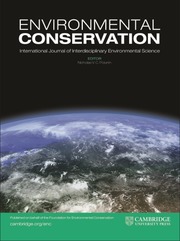Article contents
Conservation and development alliances with the Kayapó of south-eastern Amazonia, a tropical forest indigenous people
Published online by Cambridge University Press: 10 May 2002
Abstract
Legally recognized Indian reserves of Brazilian Amazonia span over 100 million ha of largely intact forest and are potentially valuable for biodiversity conservation. An important example is provided by the Kayapó territories which span more than 13 million ha in Pará and Mato Grosso, Brazil, and protect a unique and vulnerable Amazonian forest type that is poorly represented in existing nature reserves. The Kayapó of southern Pará have stopped invasion of their lands by the most perverse threats to Amazonian forests, but they have become involved extensively in the sale of illegal logging concessions for the high-value timber species mahogany (Swietenia macrophylla). In 1992, the non-governmental organization Conservation International do Brasil (CI-Brasil) began a conservation and development project with the Kayapó community of A’Ukre with the objective of providing economic alternatives to logging and protecting a population of mahogany trees. This paper demonstrates the conservation benefits that can be achieved by supporting sustainable development of indigenous peoples in the Amazon. Specifically, we: (1) evaluate the ecological importance of the Kayapó reserves from a biodiversity conservation viewpoint, (2) evaluate the conservation success of the CI-Brasil project and test whether the implementation of the conservation alliance between A’Ukre and CI-Brasil satisfies common pool resource principles, and (3) propose a model for expanding the small-scale conservation results achieved by the CI-Brasil project to all Kayapó territories. Several mammals (Tayassu pecari, Pteronura brasiliensis, Priodontes maximus, Panthera onca) and at least one bird species (Anodorhynchus hyacinthinus) listed as endangered were regularly encountered within 15 km of A’Ukre. Taxa encountered at relatively high densities in the project area included large cracids, lowland tapir, and white-lipped peccary, indicating an ecosystem that is not severely impacted by hunting. Harvest offtakes of mahogany averaged 0.44 stems ha−1 within groves and 0.13 stems ha−1 at the landscape level. We estimate that 85% of the fruiting population of Swietenia macrophylla has been removed in harvested Kayapó territories in Pará. We found Kayapó social organization in A’Ukre to meet criteria of successful common pool resource institutions. The CI-Brasil project resulted in protection of an intact mahogany population in 8000 ha of forest maintained by the community for ecological research purposes and mahogany preservation. Our analysis attributes the success of the conservation alliance with A’Ukre to: (1) direct benefits accruing to all members of the community, (2) fulfilment of criteria for development of common pool resource institutions, and (3) long-term commitment of an external agency. We propose that by implementing these three elements elsewhere, the modest conservation result achieved at A’Ukre could be expanded to include the entire Kayapó nation and thereby contribute to conservation of more than 13 000 000 ha of forest and cerrado in the south-eastern Amazon.
Keywords
- Type
- Research Article
- Information
- Copyright
- © 2001 Foundation for Environmental Conservation
- 121
- Cited by




